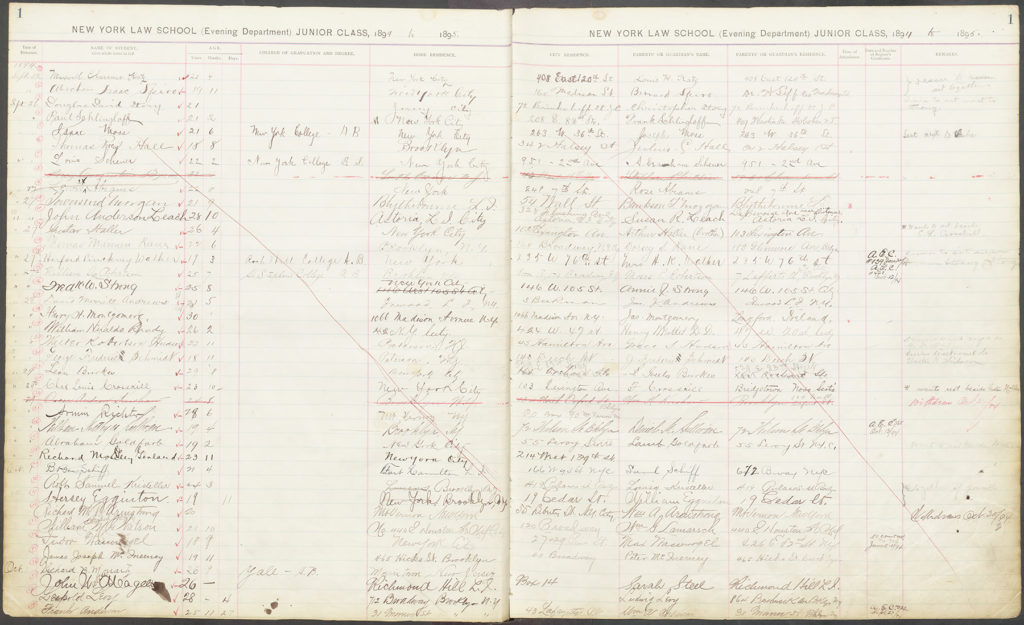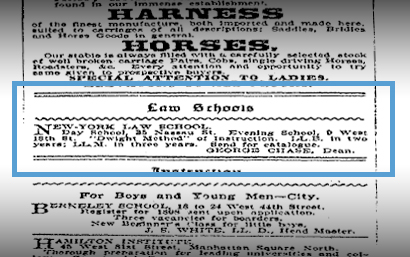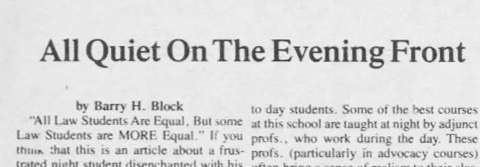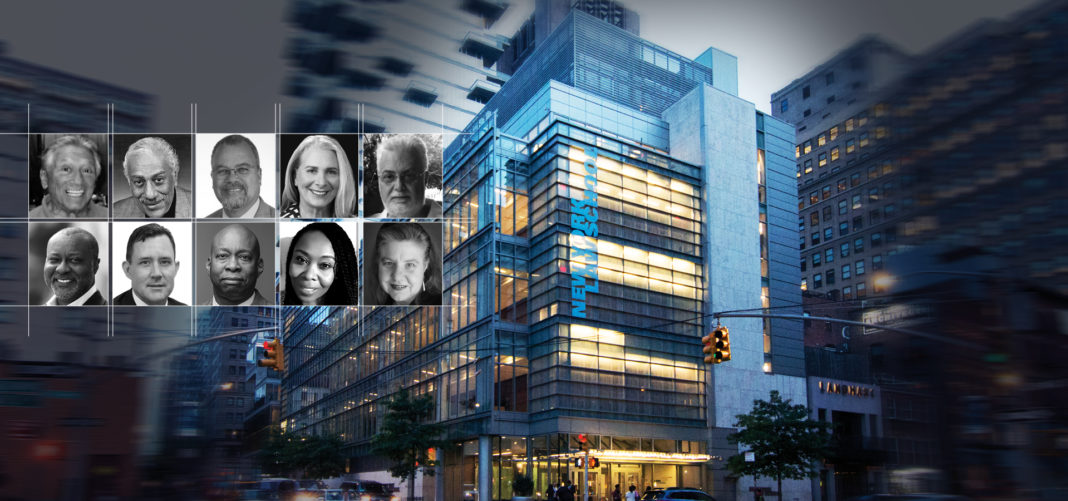HISTORY • REFLECTIONS • FUTURE
NYLS’s Evening Division was founded in 1894—the same year bottled Cola-Cola hit the market, the patent for motion picture films was granted, and Pullman Company workers launched a nationwide strike.
These developments spoke to broader societal changes: technology was accelerating, ideas were being shared further and faster than ever, and the wealth gap was widening. Meanwhile, legal education was growing and becoming formalized.
Three years prior, a group from Columbia Law School had broken away to launch NYLS. The School’s founders, propelled by a spirit of innovation, saw no reason to restrict its programming to the daytime hours. When the “Evening School,” as it was called in advertisements from the time, launched, it became a destination for working professionals, many drawn from New York’s working class communities, to advance their careers and pursue their dreams.
Get Involved:
CONNECT WITH HISTORY
NYLS’s Mendik Library showcases NYLS’s rich institutional history through Digital Commons and its collection of documents and artifacts. Alumni who wish to know more, or who have an artifact they would like to share related to the Evening Division’s history, are invited to contact Michael Roffer '83, Professor of Legal Research and Associate Librarian for Reader Services, at michael.roffer@nyls.edu or 212.431.2150.
Historical Highlights
1891: NYLS is founded by a breakaway group from Columbia Law School, driven by ideological differences in teaching methods and led by Theodore Dwight.
1894: NYLS, growing rapidly, is among the first law schools to add an “Evening School” to its offerings. Unlike daytime students, who study at 120 Broadway in the Equitable Building, evening students attend class at the Cooper Union Building in the East Village, Astor Place. Ads from the time period list both addresses.

1898: Both campuses relocate. Day students move around the corner to 35 Nassau Street. Evening students attend school at 9 West 18th Street. A New York Tribune newspaper advertisement promotes the “Dwight Method” of instruction and NYLS’s degree offerings at the time: LL.B. (two years) and LL.M. (three years).

1903: More than a decade after NYLS’s founding, evening students join day students at 35 Nassau Street. Going forward, they will study at a combined campus, even as the School subsequently relocates.
1936–37: For evening (and daytime) students, the modern naming convention of the first-year, second-year, and third-year classes is adopted. Prior classes were named “Junior,” “Middle,” and “Senior.”
1937–39: NYLS debuts a three-year afternoon and evening track and a four-year afternoon and evening track, in addition to its three-year daytime track.
1939–40: The School settles into its current structure of a three-year Day Division and a four-year Evening Division.
1969: An issue of Equitas, NYLS’s then-student newspaper, includes an article titled “Law Schools Form Consortium.” The story summarizes efforts by NYLS and three other law schools offering both day and evening courses to increase diversity in the legal profession. The consortium will do so, the article notes, by granting additional scholarships for evening students with dependents.
1990: In a May issue of the New York Law School Reporter, an evening student (Barry Block ’91) shares tips for forging stronger connections with day students. Among them: Evening students should take the occasional daytime course, spend time in the student lounge before 6:00 p.m. classes, and join a student group. In doing so, Block wrote, “day students will discover that evening students are teachers, policemen, doctors, airline pilots, and a myriad of other interesting professionals ...”

1991: The student yearbook includes an essay by Block titled “The Life of an Evening Student.” He recounts, “As evening students, most of us did not have the luxury of studying during the day. We were busy with full-time jobs ... Occasionally, we would find ourselves pitted against a young professor and saying, ‘That’s fine in principle, but it’s not the way it works in the real world.’”
1992: NYLS becomes the first law school to join the Mayor’s Graduate Scholarship Program, through which New York City employees may pursue additional higher education beyond a bachelor’s degree while working full-time. The same year, NYLS launches a special scholarship program for employees of nonprofits.
2012: Dean Anthony W. Crowell, who earned his J.D. as an evening student, is appointed Dean and President of NYLS. He is the first NYLS Dean, and one of two law school deans among 205 nationally, known to have graduated from an evening law school program.
2015: NYLS announces its Public Service Scholarship Program for members of New York City’s uniformed services and other public servants, many of whom have historically populated the Evening Division.
2019: NYLS is ranked No. 28 among national part-time J.D. programs in the 2020 U.S. News & World Report. The School secures a grant from the AccessLex Institute to explore, design, and implement responses to the particular academic and bar prep challenges evening students face. With a generous lead gift from evening graduate Arthur Metzler ’94, President and CEO of AMA Consulting Engineers, P.C., NYLS establishes the Evening Division Leadership Fund to support evening students’ academic and bar success.
Noteworthy Early Alumni
- Morris Ernst, Class of 1912: A founder of Greenbaum, Wolff & Ernst in 1915 and a close associate of President Franklin Roosevelt, Ernst was a major champion of free speech. He successfully defended the government’s efforts to ban importation of James Joyce’s allegedly obscene Ulysses. He was also the attorney for Planned Parenthood in Griswold v. Connecticut (the group submitted an amicus brief).
- James W. Watson, Class of 1913: Judge Watson became New York City’s first African American judge when he was elected to the city’s Municipal Court in 1930. He also served as President of the Municipal Civil Service Commission and was the first African American to be elected a member of the American Bar Association. (His daughter Barbara M. Watson ’62 became the first African American and first female U.S. Assistant Secretary of State.)
- David T. Wilentz, Class of 1917: As New Jersey Attorney General, Wilentz successfully prosecuted Bruno Hauptman in the Lindbergh kidnapping trial. He was also one of the founders of the prominent New Jersey firm Wilentz, Goldman & Spitzer, P.A.
- Louis Waldman, Class of 1922: Waldman, a labor lawyer and activist, was a member of the New York State Assembly and the three-time nominee of the Socialist party for New York governor. His autobiography, Labor Lawyer (1944), is part of the Mendik Library’s special collections.
- William McNamara, Class of 1923: Though inexperienced at the time, McNamara played a role in the famous 1924 Palsgraf case. Arising after an explosion in a Brooklyn train station, Palsgraf has been called “the most celebrated of all torts cases.” McNamara represented the Long Island Rail Road; though he lost at trial and on the initial appeal, he ultimately prevailed. Learn more about NYLS’s unique role in that important case.
- Glover Johnson, Class of 1925: Johnson, who became the 21st partner at White & Case, also led the New York School for the Deaf.
- Chester Carlson, Class of 1938: Carlson studied at the New York Public Library, making hand-written copies of legal texts, which he could not afford to purchase. This process strengthened his interest in building a copying machine, which he began to research and experiment with as a law student. Carlson would go on to invent the process of xerography. The first device recognizable as a modern photocopier was the Xerox 914, which was introduced on September 16, 1959.
- Florence Zimmerman, Class of 1941: NYLS’s oldest living alumna, Judge Zimmerman became one of the first 12 women to graduate from the School. After attending NYLS, she became an accomplished city attorney for New York City specializing in rent regulation and later a New York City Civil Court judge. Read more about her career.
Editor’s Note: Special thanks to the Mendik Library, especially Professor of Legal Research and Associate Librarian Michael Roffer '83, for his many research contributions to this section.


